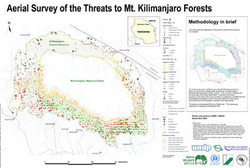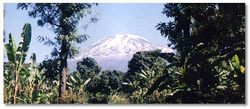
Although much of the threat to Kilimanjaro’s snowpack has been link to climate change, this does not mean that its effects cannot be mitigated or even reversed. True, it will take a lot of cooperation and quite a while to see the results, but that does not mean that it is not worth doing. We can make a change and it will take all of us humans to learn and act in whatever little way possible. As better than organic farmer Joel Salatin says, “Anything worth doing is worth doing poorly at first.” His example is that of a new toddler. When the baby uses a piece of furniture to wobbly stand itself up and then shakily try to cross the living room, we don’t scold the child and say, “If you’re not going to do it right, don’t do it at all”, we ooh and ahh and praise the child. Someone did it for us and we all walk most of the day without falling down (maybe that’s just me).
However, there are local (African) threats to Mt. Kilimanjaro. The main threat sited by the United Nations Environmental Programme on the southern slopes of the mountain relate to the loss of forests from fires and illegal logging. The group also points out that Mt. Kilimanjaro’s extensive forests with high rainfall make it a large catchment for both Kenya’s and Tanzania’s water with 96% of the water coming from Kili coming from the tree belt area. http://www.unep.org/dewa/Assessments/Ecosystems/Land/ThreatstoMtKilimanjaroforests/tabid/6966/Default.aspx
Logging with re-plantation of non-indigenous species on the northern slopes offer similar problems.
In regards to the deforestation of the slopes, further development and strength in the national park’s enforcement of its boundaries would help, however much the deforestation is for subsistence cooking fuel and tree poaching for plantation or construction. Basically the locals are trying to fight their poverty without a concept of the long term consequences. Education should be the more focused tool, but also providing other means of earning a living such as the responsible tourism practices (like the guiding services and lodges mentioned in previous blogs). Another way to combat deforestation is to try and only use woods or wood manufactured products that can be verified that they come from sustainable and fair labor/trade sources. The two most recognized international certification programs for sustainable wood and forest source goods are the Forest Stewardship Council (FSC) (both international and U.S) https://ic.fsc.org/ and Programme for the Endorsement of Forest Certification (EU based) http://www.pefc.org/. Visit their sites to learn more about sustainable forest initiatives, how they certify and you can even donate to these groups.
Besides only harvesting good woods, we can help replace what has been taken with tree planting programs and organizations. One mentioned in a previous blog is the Kilimanjaro Eco Lodge where tree planting trips can be scheduled into your stay. Another would be to volunteer or donate to groups such as the Kilimanjaro Environmental Conservation Management Trust Fund http://www.kilimanjarotrust.org/index.html. The Trust Fund identifies six areas of concern; Land degradation, Inadequate water supply, Pollution, Habitat fragmentation and loss of biodiversity, Deterioration of aquatic systems, Deforestation and Frequent forest fires, that they try to address with their programs and reforestation efforts.
However, there are local (African) threats to Mt. Kilimanjaro. The main threat sited by the United Nations Environmental Programme on the southern slopes of the mountain relate to the loss of forests from fires and illegal logging. The group also points out that Mt. Kilimanjaro’s extensive forests with high rainfall make it a large catchment for both Kenya’s and Tanzania’s water with 96% of the water coming from Kili coming from the tree belt area. http://www.unep.org/dewa/Assessments/Ecosystems/Land/ThreatstoMtKilimanjaroforests/tabid/6966/Default.aspx
Logging with re-plantation of non-indigenous species on the northern slopes offer similar problems.
In regards to the deforestation of the slopes, further development and strength in the national park’s enforcement of its boundaries would help, however much the deforestation is for subsistence cooking fuel and tree poaching for plantation or construction. Basically the locals are trying to fight their poverty without a concept of the long term consequences. Education should be the more focused tool, but also providing other means of earning a living such as the responsible tourism practices (like the guiding services and lodges mentioned in previous blogs). Another way to combat deforestation is to try and only use woods or wood manufactured products that can be verified that they come from sustainable and fair labor/trade sources. The two most recognized international certification programs for sustainable wood and forest source goods are the Forest Stewardship Council (FSC) (both international and U.S) https://ic.fsc.org/ and Programme for the Endorsement of Forest Certification (EU based) http://www.pefc.org/. Visit their sites to learn more about sustainable forest initiatives, how they certify and you can even donate to these groups.
Besides only harvesting good woods, we can help replace what has been taken with tree planting programs and organizations. One mentioned in a previous blog is the Kilimanjaro Eco Lodge where tree planting trips can be scheduled into your stay. Another would be to volunteer or donate to groups such as the Kilimanjaro Environmental Conservation Management Trust Fund http://www.kilimanjarotrust.org/index.html. The Trust Fund identifies six areas of concern; Land degradation, Inadequate water supply, Pollution, Habitat fragmentation and loss of biodiversity, Deterioration of aquatic systems, Deforestation and Frequent forest fires, that they try to address with their programs and reforestation efforts.

Vibrant African Forests around Mt. Kilimanjaro
Please remember, that although it seems like everyone asks for money, 1) a healthy donation is still cheaper than flying to Africa (and a smaller carbon footprint) and 2) money is a tool that is extremely versatile and does not spoil. It can be used in a variety of ways that time and muscle may not meet.
So as with all aspects of things you care about, be thoughtful, research where your money is going, whether it is a guide, food, lodge or where to donate and make it count.
The other home front effort that anyone and everyone should be carrying out and getting a little better at everyday is to try and lower your carbon footprint in the thousands of ways we know. It truly is the Butterfly Effect that you unplugging your computer or turning on a fan instead of the A/C in Utah, the U.S. or wherever may keep the Snows of Kilimanjaro around just a little longer.
Thanks for your efforts in advance!
So as with all aspects of things you care about, be thoughtful, research where your money is going, whether it is a guide, food, lodge or where to donate and make it count.
The other home front effort that anyone and everyone should be carrying out and getting a little better at everyday is to try and lower your carbon footprint in the thousands of ways we know. It truly is the Butterfly Effect that you unplugging your computer or turning on a fan instead of the A/C in Utah, the U.S. or wherever may keep the Snows of Kilimanjaro around just a little longer.
Thanks for your efforts in advance!

 RSS Feed
RSS Feed